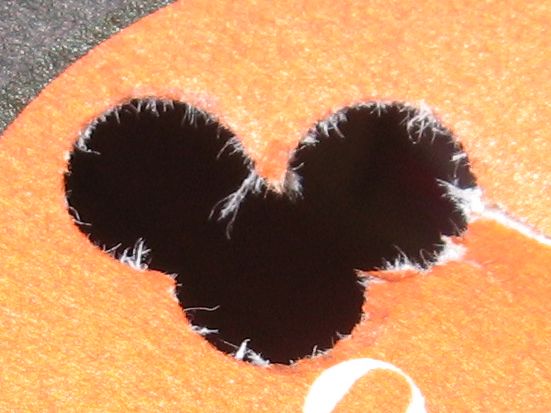After shooting and cleaning the guns today, I took some photos of them. With the lighting just right, this tight shot of the logo and checkering on this S&W 908 9mm pistol reminds me of pop art.
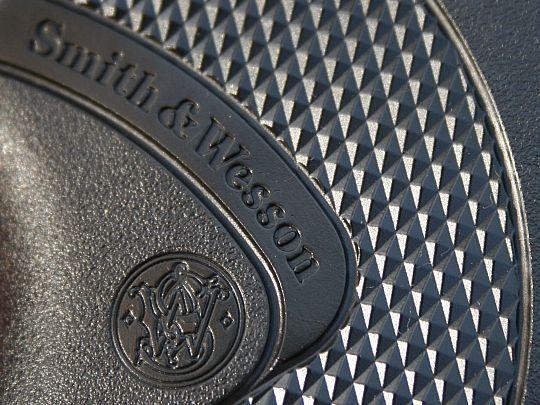
After shooting and cleaning the guns today, I took some photos of them. With the lighting just right, this tight shot of the logo and checkering on this S&W 908 9mm pistol reminds me of pop art.

This is the hardware we took to the range today for our weekly target practice. Nicely packed in our new Pelican Case model 1450, (from top left, clockwise) Glock 30, Glock 26, S&W 908, S&W 442 and S&W 686.
We acquired the case a couple of weeks ago. As you see, it nicely holds these five compact firearms. The case is rugged, watertight, dust proof and has stainless steel hinge pins and padlock hardware. We didn’t have to modify the foam that shipped with the case although it accommodates removal of ‘cubes’ to fit any custom shape.
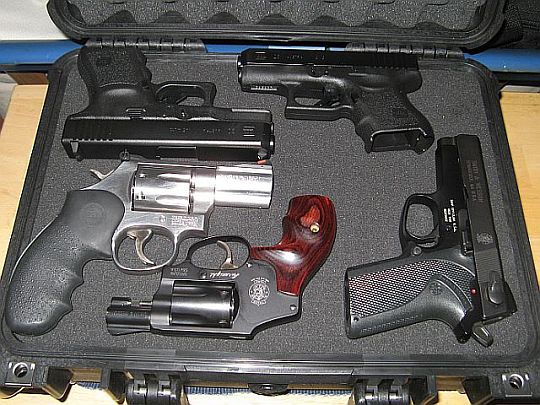
This past weekend, I took some video while Damsel was shooting at the range. Apparent in the videos was the flash associated with firing. Also apparent, is the concussion and report. I did some research and found these interesting characteristics associated with Muzzle Blast:
Muzzle blast characteristics
The muzzle blast is often broken down into two components, an auditory component and a non-auditory component. The auditory component, the sound of the muzzle blast, is important because it can cause hearing loss or give away the gun’s position, while the non-auditory component, the overpressure wave, can cause damage to items near the blast.
Auditory
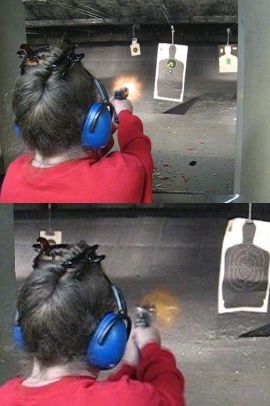
Image – Damsel firing (top) the Glock 30
and (bottom) Smith & Wesson 686
Non -auditory
Not apparent in the images above is the report and concussion. Both the .45 and .357 have a loud report and although the flash appears less intense in the .357, the concussion is significantly stronger than the .45.
 U.S. Senator Kay Bailey Hutchison (R-TX) led the charge in the U.S. Congress where she, and 54 other Senators, along with 250 U. S. Representatives and Vice President Dick Cheney signed on to one of the many amici filed in the D.C. vs. Heller case. Senator Hutchison also authored an article containing rationale on how the D.C. Gun Ban affects the entire nation.
U.S. Senator Kay Bailey Hutchison (R-TX) led the charge in the U.S. Congress where she, and 54 other Senators, along with 250 U. S. Representatives and Vice President Dick Cheney signed on to one of the many amici filed in the D.C. vs. Heller case. Senator Hutchison also authored an article containing rationale on how the D.C. Gun Ban affects the entire nation.
In the article, Senator Hutchison concludes:
The U.S. Supreme Court has the perfect case to affirm an individual’s Second Amendment right to self-defense. Though gun-control advocates have questioned this through the years, Congress never has.
From the Freedman’s Bureau Act of 1865 to the Property Requisition Act of 1941, Congress reaffirmed the solemn position of the U.S. as a defender of one’s right to protect his being and his home with an operable firearm. I hope the Supreme Court will affirm the individual right to self-defense with a firearm so that it is clear and unambiguous.
It is an opportunity, perhaps, of a lifetime.
 Meanwhile, Texas Solicitor General Ted Cruz, organized the Solicitors General from 31 States in filing another amicus brief. The 31 states filed a brief explaining that “the individual right to keep and bear arms is protected by the United States Constitution and the constitutions of forty-four states.” The 31 amici states also note that “the District of Columbia’s categorical gun ban is markedly out of step with the judgment of the legislatures of the fifty states, all of which protect the right of private citizens to own handguns.”
Meanwhile, Texas Solicitor General Ted Cruz, organized the Solicitors General from 31 States in filing another amicus brief. The 31 states filed a brief explaining that “the individual right to keep and bear arms is protected by the United States Constitution and the constitutions of forty-four states.” The 31 amici states also note that “the District of Columbia’s categorical gun ban is markedly out of step with the judgment of the legislatures of the fifty states, all of which protect the right of private citizens to own handguns.”
Ted Cruz will argue the States’ rebuttal to the petitioners ‘state militia’ before the Supreme court. Alan Gura, one of the attorneys arguing the case on behalf of Heller, has allotted time for Ted to engage the Court’s attention.
Gura, in his post The States Weigh In speaks highly of Ted Cruz, while allowing as how the U.S. Solicitor General, with their failure of principle and logic, can get their own time for arguments.
The opportunity to collaborate with so many old friends is among the many perks of working this case. Among our amici briefs coming this Monday, we expect a brief from over thirty states, voicing support for the individual right view and rejecting the Petitioners’ “state militia” theory, authored by Texas SG Ted Cruz. I’ve known and respected Ted for many years for his legal (and poker) acumen. Considering the significance of this brief, we’re delighted to consent to Ted’s request for ten minutes of argument time. [Ted and I had discussed dividing argument time at the D.C. Circuit stage, but we did not have enough time to divide.]
Of course, we would not begrudge the U.S. Solicitor General’s desire for argument time as well. However, considering his position is adverse to our clients, it would be inappropriate for him to detract from our argument time. Accordingly, we suggest to the Court that should the U.S. Solicitor General desire argument time, he be granted such time in addition to, and not instead of, the parties’ time.
Thanks to Senator Hutchinson and Ted Cruz – and also to many other significant Respondents Amici, there will be a lot of energy working to save our basic second amendment freedoms.
 For the last couple of weeks, we have used these huge silhouette targets at the range. First, we use the target when we shoot our hand guns. When there are too many holes in it to see what we’re hitting, we haul it back in and stick on an adhesive target (we get the ‘Shoot ‘n’ See’ targets that turn neon green at the point of impact). The adhesive target rejuvenates the silhouette enough for at least the next box or two of rounds.
For the last couple of weeks, we have used these huge silhouette targets at the range. First, we use the target when we shoot our hand guns. When there are too many holes in it to see what we’re hitting, we haul it back in and stick on an adhesive target (we get the ‘Shoot ‘n’ See’ targets that turn neon green at the point of impact). The adhesive target rejuvenates the silhouette enough for at least the next box or two of rounds.
Image right – Damsel gets ready to unload on the target.
 Finally, it’s time for the shotguns. These targets usually don’t last too long after the shot starts flying, and are frequently shot off of the target tee. This hardy fellow, however, hung in for all fifty rounds (25 twelve and 25 twenty gauge shells). He wasn’t much of his former self, but he saw to it we got our money’s worth. Now don’t get me wrong – we can afford targets and often will put one up for a few rounds to check sighting and individual accuracy. Today, however, we were having a lot of fun seeing how long this one would last.
Finally, it’s time for the shotguns. These targets usually don’t last too long after the shot starts flying, and are frequently shot off of the target tee. This hardy fellow, however, hung in for all fifty rounds (25 twelve and 25 twenty gauge shells). He wasn’t much of his former self, but he saw to it we got our money’s worth. Now don’t get me wrong – we can afford targets and often will put one up for a few rounds to check sighting and individual accuracy. Today, however, we were having a lot of fun seeing how long this one would last.
Image left – remnants of the target as we prepared to leave for the day. Click either picture for a closer look.
Every trip we make to the gun show (about every other month here), we pick up several tablets of 2×3 paper targets. We generally use the paper targets when we shoot our shotguns at the range. Understandably, we go through about four or five targets in a session. Most times, we bring twenty-five 20 gauge and twenty-five 12 gauge target loads.
In the video at the right, Damsel cranks out five 20 gauge rounds and shreds up the target pretty good. The still panels following the video are a fresh target, after 5 rounds and after 10 rounds – the last one is ready to haul in and start the cycle over again.
Note: You must enable JavaScript and Flash® to see the video.
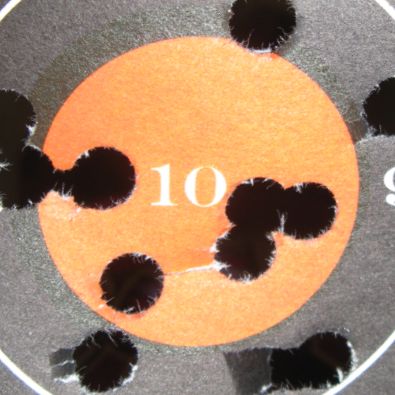 Wadcutters tend to cut nice, clean holes in a paper target. A wadcutter is a bullet specially designed for shooting paper targets, usually at close range and with significantly subsonic velocities under 800 ft/s (244 m/s) such as are found in handgun and airgun competitions.
Wadcutters tend to cut nice, clean holes in a paper target. A wadcutter is a bullet specially designed for shooting paper targets, usually at close range and with significantly subsonic velocities under 800 ft/s (244 m/s) such as are found in handgun and airgun competitions.
A wadcutter has a flat or nearly flat front, which acts to cut a very clean hole through the target, making it easier to score and ideally reducing errors in scoring to the favor of the shooter.
Occasionally, a grouping can resemble a celebrity mouse if you orient the target just right:
